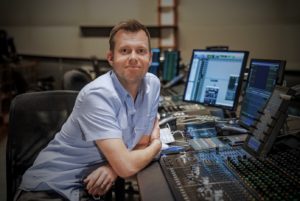
Master sound editor and sound designer Julian Slater (Mad Max: Fury Road, Scott Pilgrim vs. the World) envelopes the audience in a world of syncopation in Edgar Wright’s summer hit film, Baby Driver. Syncopation means a disturbance or interruption of the regular flow of rhythm, such as the tempo of that track is not a fixed tempo. The sound editor simplified, “The first car chase sequence for example, the skids and engine revs are in sync and in tempo, the helicopter blades are pulsating in rhythm with the music track. What we do is feature it in the mix when it’s working and it sounds cool and then we take it out of the mix when it’s going a bit crazy and sloppy, so the audience doesn’t hear that, then we reintroduce it back at a time when it is working with the music.”
The sound design for this particular film was fashioned inversely compared to the designer’s previous projects. “First of all, we normally work in timecode or feet and frames, but we worked in bars and beats for this. As a car alarm goes off at the same time as the music, we would have to pitch correct it, to make sure it’s in the same key as the music cue it’s playing against. We have to time-stretch it, so it’s in tempo with the music cue, and then we have to make sure that it sounds realistic, because sometimes when you pitch and stretch stuff to make it work with the music, it doesn’t actually sound very good. It’s like a three-check box tick process for every sound. We tempo map each piece of music and then map that tempo to the sound effects we were using. It was a mixture of two things, how we did the sound editorial to make it work with the music and then we mixed it, because Baby (Ansel Elgort) is in every scene of the movie, and we wanted the audience to experience his world through his ears,” Slater explained.
The Oscar nominee continued, “You do what’s called time-stretching, so you make it longer or make it shorter without effecting its pitch, because normally if you slow something down, the pitch goes down. We would time-stretch every sound, then once it was working in sync and rhythm with the music track, would then pitch it either up or down. And then also old-fashioned editing. Mixture of time-stretching, pitch correction, and intense editing.”
The emotional trigger indeed emanates from the assembly of the sound editing. “All the sound design in that first car chase has every sound effect working perfectly in the same pitch of the music cue. In the next car chase, it all goes wrong and some guy starts shooting at them. Then we start detuning the sound effects, but still in sync. Likewise, the tinnitus; it’s always there if the music is not in the movie. As we go further into the story, his world is closing in on him, and the tinnitus gets louder as his stress levels go up,” expressed Slater.
Julian Slater transports us into the aural world of Baby through this innovative sound editing. Baby Driver combines every element of sound to flow slickly in sync as one entity as it captivates the audience to deliver a harmonious sensation of rhythm and tempo. Slater concluded, “We made as much of the sound design work with the music so it all becomes like a symphonic cacophony.”





